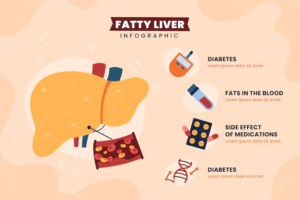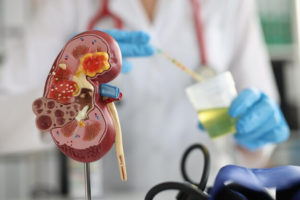Understanding Neonatal Jaundice and Ayurvedic Approaches to Treatment
Understanding Neonatal Jaundice and Ayurvedic Approaches to Treatment is a common condition affecting newborns, characterized by the yellowing of the skin and eyes due to elevated levels of bilirubin in the blood. While it often resolves on its own, understanding its causes, types, and treatment options is essential for parents and caregivers. This blog explores neonatal jaundice and examines how Ayurveda, the ancient Indian system of medicine, approaches its management.
What is Neonatal Jaundice?

Neonatal jaundice occurs when there is an excess of bilirubin, a yellow pigment produced during the breakdown of red blood cells. Bilirubin is processed by the liver and excreted in bile. In newborns, especially those born prematurely, the liver may not be mature enough to process bilirubin efficiently, leading to its accumulation in the blood.
Types of Neonatal Jaundice
- Physiological Jaundice: This is the most common type and typically appears within the first week of life. It is usually harmless and resolves without treatment.
- Pathological Jaundice: This type appears within the first 24 hours of life and may indicate underlying health issues, such as blood group incompatibility, infections, or metabolic disorders. Pathological jaundice requires careful monitoring and potential medical intervention.
- Breastfeeding Jaundice: This can occur in breastfed infants due to inadequate feeding, leading to dehydration and increased bilirubin levels.
- Breast Milk Jaundice: This occurs in some breastfed infants after the first week of life, attributed to substances in breast milk that may inhibit bilirubin excretion. It usually resolves by itself.
Causes of Neonatal Jaundice
Several factors can contribute to the development of neonatal jaundice:
- Immature Liver Function: Newborns, especially preterm infants, have immature livers that may not effectively process bilirubin.
- Increased Red Blood Cell Breakdown: Conditions like hemolytic disease of the newborn can cause rapid breakdown of red blood cells, increasing bilirubin levels.
- Inadequate Feeding: Poor feeding can lead to dehydration, reducing the frequency of bowel movements and the excretion of bilirubin.
- Blood Group Incompatibility: Rh or ABO incompatibility between the mother and baby can lead to increased bilirubin levels.
Symptoms of Neonatal Jaundice
The primary symptom of neonatal jaundice is the yellowing of the skin and sclera (the white part of the eyes). Other signs may include:
- Dark yellow urine
- Pale or clay-colored stools
- Lethargy or decreased activity
- Poor feeding
Parents should monitor their newborns closely, especially in the first few days of life, and consult a healthcare provider if jaundice appears.
Ayurvedic Perspective on Neonatal Jaundice
Ayurveda views health as a balance between the body, mind, and spirit. In this system, neonatal jaundice is often linked to an imbalance in the doshas (the three fundamental bodily energies: Vata, Pitta, and Kapha). Specifically, excess Pitta, which governs metabolism and transformation, is associated with the yellow color and heat of jaundice.
Causes of Jaundice in Ayurveda
In Ayurveda, jaundice is referred to as “Pittaja Yellow.” It is believed that an imbalance of Pitta dosha leads to an accumulation of toxins (ama) in the body, which can be caused by:
- Inappropriate diet during pregnancy
- Stress or emotional disturbances
- Poor digestion or metabolic issues in the newborn
Ayurvedic Treatment Approaches
- Dietary Modifications:
- For Nursing Mothers: It is crucial for breastfeeding mothers to consume a balanced diet rich in fresh fruits, vegetables, whole grains, and adequate hydration. Foods that pacify Pitta, such as cucumbers, melons, and sweet fruits, are beneficial.
- For the Baby: Ensuring adequate breastfeeding is vital. Ayurvedic practitioners may recommend specific herbal preparations or tonics to enhance the mother’s milk supply if necessary.
- Herbal Remedies:
- Neem (Azadirachta indica): Known for its detoxifying properties, neem can help reduce bilirubin levels. However, it should be used cautiously and under professional guidance.
- Turmeric (Curcuma longa): This spice has anti-inflammatory properties and can support liver function. Turmeric can be added to the mother’s diet to benefit the nursing infant.
- Amla (Emblica officinalis): Amla is known for its ability to support digestion and detoxification, which can help manage bilirubin levels.
- Hydration:
- Ensuring that the newborn is well-hydrated is crucial for the excretion of bilirubin. Ayurvedic practices may recommend specific herbal teas for mothers that promote lactation and hydration.
- Sunlight Exposure:
- Moderate sunlight exposure can help break down bilirubin through phototherapy. Ayurvedic practitioners often recommend exposing the baby to early morning sunlight while ensuring protection from direct rays.
- Panchakarma:
- In more severe cases, Ayurvedic detoxification therapies, known as Panchakarma, may be considered under professional supervision. These therapies aim to cleanse the body of toxins and restore balance.
Monitoring and Consultation
While Ayurvedic treatments can complement conventional medical care, it is crucial for parents to work closely with pediatricians. Regular monitoring of bilirubin levels is essential to prevent complications associated with high bilirubin levels, such as kernicterus, a rare but serious condition.
Conclusion
Understanding Neonatal Jaundice and Ayurvedic Approaches to Treatment while often a normal physiological response in newborns, requires attention and care. Understanding its causes, types, and treatment options empowers parents to make informed decisions regarding their baby’s health.
Ayurveda offers holistic approaches that can support the management of neonatal jaundice, focusing on diet, herbal remedies, and lifestyle modifications. However, it is essential to approach this condition with a balanced perspective, integrating both Ayurvedic and conventional medical practices for the best outcomes.
By staying informed and proactive, parents can ensure the health and well-being of their newborns, navigating the journey of neonatal jaundice with confidence and care.








Leave a reply